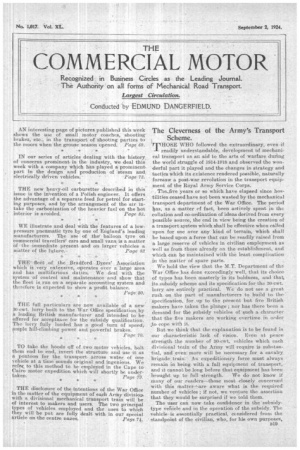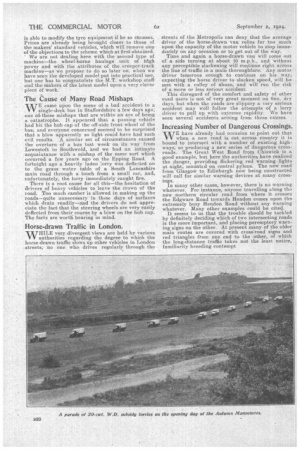The Cleverness of the Army's Transport Scheme.
Page 1

Page 2

If you've noticed an error in this article please click here to report it so we can fix it.
rpHosE WHO followed the extraordinary, even if -Ireadily understandable, development of mechanical transport as an aid to the arts of warfare during the world struggle of 1914-1918 and observed the won' derful part it played and the changes in strategy and tactics which its existence rendered possible, naturally foresaw a post-war revolution in the transport equipment of the Royal Army Service Corps.
• . The_five years or so 'which have elapsed since hostilities ceased have not been wasted by the mechanical transoort department of the War Office. The period has, as a matter ef fact, been actively spent in the collation and co-ordination of ideas derived from every possible source, the end in view being the creatiep of a transport system which shall be effective when called upon for use over any kind of terrain, which shall be based upon a force that can be readily raised from a large reserve of vehicles in civilian employment as well as from those already on the establishment, and which can be maintained with the least complication in the matter of spare parts.
We 'hold the view that the M.T. Department of the War Office has done exceedingly well, that its choice of types has ;been masterly in its boldness, and that its subsidy scheme and its specification for the 20-cwt. lorry are entirely practical. We do not see a greats rush on the part Of manufacturers to build to thern specification, for up to the present but five British makers have taken the plunge; nor has there been a demand for the subsidy vehicles of such a character that the five makers are working overtime in order „,to cope with it.
But we think that the explanation is to be found in our characteristic lack Of vision. Even at peace strength the number of 30-cwt, vehicles which each divisional train of the Army will -require is substantial, and even. more will be necessary ior a cavalry brigade train: An expeditionary force must always remain in being with a full equipment of transport, and it cannot be long before that equipment has been brought up to full strength. We do not know if many of our readers—those most closely concerned with this matter-f--are aware what is the required number of vehicles ; if not, we venture the assertion that they would be surprised if We told them.
The user can nowtake confidence in the subsidytype verdcle and in the operation Of the subsidy. The vehicle is essentially practical, considered from the standpoint of the civilian, who, for his own purposes, is able to modify the tyre equipment if he so chooses. Prices are already being brought closer to those of the makers' standard vehicles, which will remove one of the objections to the scheme which at first obtained. ' We are not dealing here with the second type of machine—the wheel-borne haulage unit of high power and with the attributes of the creeper-track maehine—as we propose to do so later on. when we have seen the developed model put into practical use, but one has to congratulate the M.T. workshop staff and the makers of the latest model upon a very clever piece of work:
The Cause of Many Road Mishaps.
WE came upon the scene of a bad accident to a single-deck bus in Staffordshire a few days ago, one of those mishaps that are within an ace of being a catastrophe. It appeared that a passing vehicle had hit the hub cap of the off-side front wheel of the bus, and everyone concerned seemed to be surprised that a blow apparently so light could have had such evil results. A similar set of circumstances caused the overturn of a bus last week on its way from Lowestoft to Southwold, .and we had an intimate acquaintance with a mishap of the same sort which occurred a few years ago on the Epping Road. A fortnight ago a heavily laden lorry was defie2ted on to the grass water table of. a South Lancashire main road through a touch from a small car, and, unfortunately, the lorry immediately caught fire.
There is a root cause for all this—the hesitation of drivers of heavy vehicles to leave the crown of the road. Too much camber is allowed in making up the roads—quite unnecessary in these days of surfaces which drain readily—and the drivers do not appreciate the fact that the steering wheels are very easily deflected from their course by a blow on the hub cap. The facts are worth bearing in mind.
Horse-drawn Traffic in London.
WHILE very divergent views are held by various authorities regarding the degree to which the horse-drawn traffic slows up other vehicles in London streets, no one who drives regularly through the
streets of the Metropolis can deny that the average driver of the horse-drawn van relies far too much upon the capacity of the motor vehicle to stop immediately on any occasion or to get out of the way. Time and again a horse-drawn van will come out of a side turning at about 10 m.p.h., and without any perceptible slackening will continue right across the line of traffic in a main thoroughfare. Any motor driver temerous enough to continue on his way, expecting the horse driver to slacken speed, will be met with a volley of abuse, and will run the risk of a more or less serious accident.
This disregard of the comfort and safety of other road users is not of very great moment on fine, dry days, but when the roads are slippery a very serious accident may well follow the attempts of a lorry driver to pull up with extreme rapidity. We have seen several accidents arising from these causes.
Increasing Number of Dangerous Crossings.
wE have already had occasion to point out that when a new road is cut across country it is bound to intersect with a number of existing highways, so producing a new series of dangerous crossroads. The Great West Road from Chiswick is a good example, but here the authorities have realized the danger, providing flickering red warning lights at night, mountcd on central pylons. The new road from Glasgow to Edinburgh now being constructed will call for similar warning devices at many crossings.
In many other cases, however, there is no warning whatever. For instance, anyone travelling along the new northern circular road from where it crosses the Edgware Road towards Hendon comes upon the extremely busy Hendon Road without any warning whatever. Many other examples could be cited. It seems to us that the trouble should be tackled by definitely deciding which of two intersecting roads is the more important, and placing peremptory warningsigns on the other. At present many of the older main routes are covered with cross-road signs and red triangles from one end to the other, of which the long-distance traffic takes not the least notice, familiarity breeding contempt






























